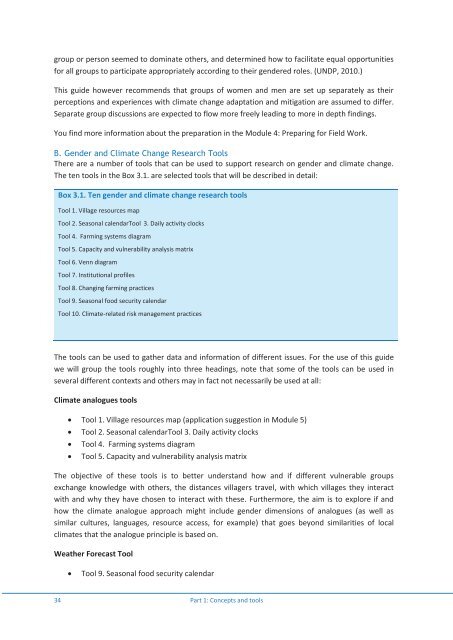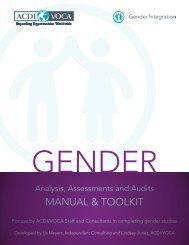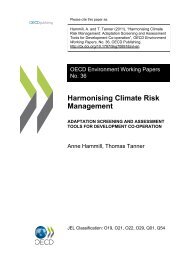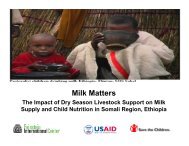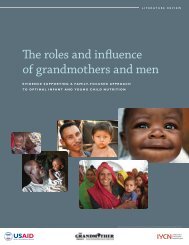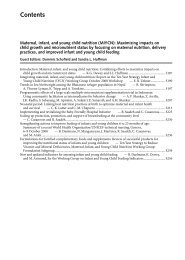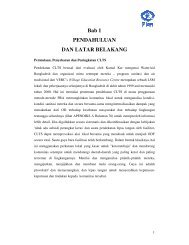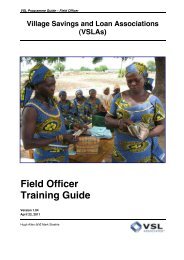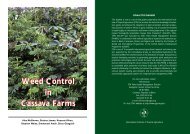Gender and climate change research in - FAO
Gender and climate change research in - FAO
Gender and climate change research in - FAO
You also want an ePaper? Increase the reach of your titles
YUMPU automatically turns print PDFs into web optimized ePapers that Google loves.
group or person seemed to dom<strong>in</strong>ate others, <strong>and</strong> determ<strong>in</strong>ed how to facilitate equal opportunities<br />
for all groups to participate appropriately accord<strong>in</strong>g to their gendered roles. (UNDP, 2010.)<br />
This guide however recommends that groups of women <strong>and</strong> men are set up separately as their<br />
perceptions <strong>and</strong> experiences with <strong>climate</strong> <strong>change</strong> adaptation <strong>and</strong> mitigation are assumed to differ.<br />
Separate group discussions are expected to flow more freely lead<strong>in</strong>g to more <strong>in</strong> depth f<strong>in</strong>d<strong>in</strong>gs.<br />
You f<strong>in</strong>d more <strong>in</strong>formation about the preparation <strong>in</strong> the Module 4: Prepar<strong>in</strong>g for Field Work.<br />
B. <strong>Gender</strong> <strong>and</strong> Climate Change Research Tools<br />
There are a number of tools that can be used to support <strong>research</strong> on gender <strong>and</strong> <strong>climate</strong> <strong>change</strong>.<br />
The ten tools <strong>in</strong> the Box 3.1. are selected tools that will be described <strong>in</strong> detail:<br />
Box 3.1. Ten gender <strong>and</strong> <strong>climate</strong> <strong>change</strong> <strong>research</strong> tools<br />
Tool 1. Village resources map<br />
Tool 2. Seasonal calendarTool 3. Daily activity clocks<br />
Tool 4. Farm<strong>in</strong>g systems diagram<br />
Tool 5. Capacity <strong>and</strong> vulnerability analysis matrix<br />
Tool 6. Venn diagram<br />
Tool 7. Institutional profiles<br />
Tool 8. Chang<strong>in</strong>g farm<strong>in</strong>g practices<br />
Tool 9. Seasonal food security calendar<br />
Tool 10. Climate-related risk management practices<br />
The tools can be used to gather data <strong>and</strong> <strong>in</strong>formation of different issues. For the use of this guide<br />
we will group the tools roughly <strong>in</strong>to three head<strong>in</strong>gs, note that some of the tools can be used <strong>in</strong><br />
several different contexts <strong>and</strong> others may <strong>in</strong> fact not necessarily be used at all:<br />
Climate analogues tools<br />
Tool 1. Village resources map (application suggestion <strong>in</strong> Module 5)<br />
Tool 2. Seasonal calendarTool 3. Daily activity clocks<br />
Tool 4. Farm<strong>in</strong>g systems diagram<br />
Tool 5. Capacity <strong>and</strong> vulnerability analysis matrix<br />
The objective of these tools is to better underst<strong>and</strong> how <strong>and</strong> if different vulnerable groups<br />
ex<strong>change</strong> knowledge with others, the distances villagers travel, with which villages they <strong>in</strong>teract<br />
with <strong>and</strong> why they have chosen to <strong>in</strong>teract with these. Furthermore, the aim is to explore if <strong>and</strong><br />
how the <strong>climate</strong> analogue approach might <strong>in</strong>clude gender dimensions of analogues (as well as<br />
similar cultures, languages, resource access, for example) that goes beyond similarities of local<br />
<strong>climate</strong>s that the analogue pr<strong>in</strong>ciple is based on.<br />
Weather Forecast Tool<br />
<br />
Tool 9. Seasonal food security calendar<br />
34 Part 1: Concepts <strong>and</strong> tools


